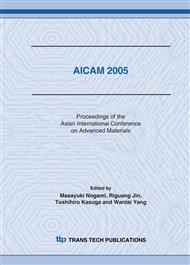p.65
p.69
p.73
p.77
p.81
p.85
p.89
p.95
p.101
Microstructure and Mechanical Property of 3D Textile C/SiC Composites Fabricated by Chemical Vapor Infiltration
Abstract:
Three dimensional textile carbon fiber reinforced silicon carbide (3D textile C/SiC) composites with pyrolytic carbon interfacial layer were fabricated by chemical vapor infiltration. The microstructure and mechanical property of 3D textile C/SiC composites were investigated. A thin pyrolysis carbon layer (0.2 ± μm) was firstly deposited on the surface of carbon fiber as the interfacial layer with C3H6 at 850°C and 0.1 MPa. Methyltrichlorosilane (CH3SiCl3 or MTS) was used for the deposition of the silicon carbide matrix. The conditions used for SiC deposition were 1100°C, a hydrogen to MTS ratio of 10 and a pressure of 0.1 MPa. The density of the composites was 2.1 g cm-3. The flexural strength of the 3D textile C/SiC composites was 438 MPa. The 3D textile C/SiC composites with pyrolytic carbon interfacial layer exhibit good mechanical properties and a typical failure behavior involving fibers pull-out and brittle fracture of sub-bundle. The real part (ε′) and imaginary part (ε″) of the complex permittivity of the 3D-C/SiC composites are 51.53-52.44 and 41.18-42.08 respectively in the frequency range from 8.2 to 12.4 GHz. The 3D-C/SiC composites would be a good candidate for microwave absorber.
Info:
Periodical:
Pages:
81-84
Citation:
Online since:
February 2006
Authors:
Price:
Сopyright:
© 2006 Trans Tech Publications Ltd. All Rights Reserved
Share:
Citation:


